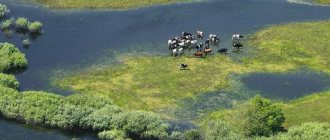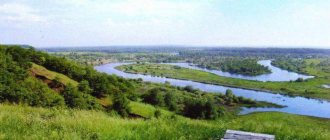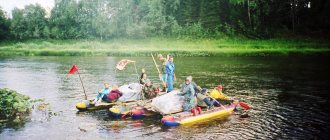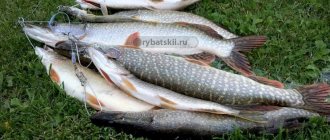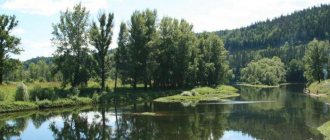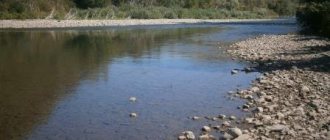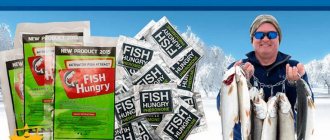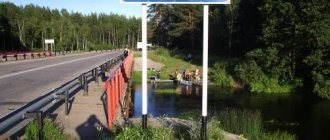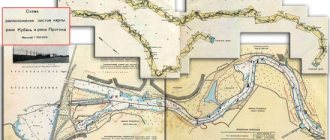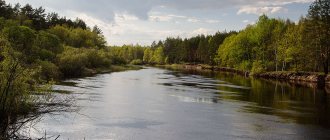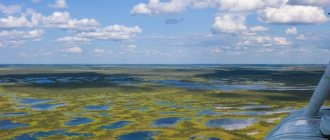Description of the reservoir
The Seim River is medium in size. It flows through the territory of the Belgorod and Kursk regions, as well as through the Sumy and Chernigov regions of Ukraine. The characteristics of the reservoir are as follows:
- river length – 696 km;
- pool area – 27500 sq. km;
- water consumption - 99.6 cubic meters. meters per second;
- the river slope is directed to the southwest;
- the width of the channel ranges from 10 to 100 meters;
- average depths are about 2–3 meters, maximum depths are up to 15 meters.
The Seim River originates in the Central Russian Upland. There are two versions regarding the exact location of the source of the reservoir:
- in the area of the village of Verkhoseimye, Manturovo district, Kursk region;
- near the Morozov farm in the Belgorod region of the Gubkinsky urban district.
Almost 65% of the Seim River basin area is in the Kursk region. Its valley is wide, the main rocks are chalk and limestone. The banks are hilly, in some places reaching a height of up to 40 meters. There are many ravines and ravines along the riverbed, and there are open and wooded areas.
In the upper reaches, the width of the Seim ranges from 10 to 20 meters
In the upper reaches the width of the Seim does not exceed 20 meters. In the middle reaches - from 40 to 80 meters. In the lower reaches the river overflows to 80–100 meters. The depths are also varied. On riffles - from 20 cm to a meter, on reaches and calm areas - 2-4 meters, there are holes and pools from 10 to 15 meters.
The river bed is winding, smoothly but noticeably “winding”, forming bends and pronounced turns. The current is mostly moderate, there are areas with rapids, and there are quiet reaches. The diet freezes at the end of November - beginning of December, opens at the end of March, less often at the beginning of April. The flood lasts until the end of May.
For reference! The Seim River is fed by snow.
In the Kurchatovsky district of the Kursk region, the Seim flows along an artificial channel created during the construction of the Kursk Nuclear Power Plant. There are many settlements on the banks of the reservoir, including Kursk, Solntsevo, Pryamitsyno, the Karl Liebknecht Village, Lgov, as well as Kudintsevo, Rylsk, Glushkovo, Zvannoye, Tetkino.
The Seim River flows through Russia and Ukraine and is a left tributary of the Desna
Within the Kursk region, the Seim River has 639 tributaries. From the left we can note:
- Seimitsa;
- Donetsk Seimitsa;
- Full;
- Reut;
- Strong;
- Snagost.
Among the right tributaries, the most significant are Leshchinka, Rat, Tuskar, Bolshaya Kuritsa, Svapa, Amonka. There are about 1000 lakes in the Seim basin. The main ones are Lezvino, Malino, Makovye, Fitizh.
For reference! The map shows that the main tributaries of the Seim in the Kursk region are the Svapa and Tuskar rivers.
The Seim riverbed forms many bends and smooth turns
The banks of the Seim are densely populated. Therefore, the reservoir is actively used for economic purposes, for example, for irrigation of agricultural land. The river is not navigable along its entire channel, as there are embankments and shoals along its length. It is necessary to check the routes annually and clean them, which is done irregularly.
Paid fishing
As already mentioned, in general, there are many reservoirs in the Kursk region, some of which do not require payment for fishing, and in some of them fishing is paid.
Among professional fishermen, one of the favorite places is the Znamenka reservoir, located in the Kursk region. By the way, amateurs often visit this place. The place is popular not only for fishing, but also because you can simply relax there and relax away from the city. It is not difficult to get to the reservoir; it is located near the village of Znamenka, Medvensky district.
There is a great variety of different fish in the reservoir:
Recommended gear is a spinning rod and a float rod. Bait should be chosen according to the season; the best results are shown by canned peas and corn, worms and maggots, as well as dough with semolina.
Pond Trinity
The water here has not been drained for nine years, which means that a really large specimen can be hooked. This reservoir is replenished with up to half a kilogram of carp every year. Examination of water, fish and even sludge is carried out regularly. It’s easy to guess that the water is quite clean and, of course, suitable for fish farming. The fishing season opens in early April and ends in autumn. Almost any place is suitable for fishing and the choice of places is great. Lanterns have been installed for night fishing enthusiasts. In general, the entire coastline is constantly cleared of debris.
Use as bait
The Troitsk reservoir contains the following fish species:
- Hungarian carp, still a small fish.
- Perch
- crucian carp
- Roach
- White amur
- Silver carp
- Tench
- Sturgeon
- Carp
This reservoir is located twenty kilometers from Kursk in the village of Troitsa. Finding it is not difficult along the entire highway and there are signs after the exit. After leaving the highway, you need to drive along a dirt road for no more than three kilometers until the reeds appear, this will be Trinity Pond.
To avoid driving on a dirt road, before reaching the village, you can turn 5 kilometers along an asphalt road and get to the big water.
Even minibuses lead to the reservoir.
What kind of fish live
The Seim is a fish river inhabited by a variety of ichthyofauna. Its main inhabitants are:
- chub;
- roach;
- perch;
- pike.
In smaller quantities here are found white bream, white bream, ide, rudd, tench, crucian carp, asp, and bluegill. In the lower reaches there are pike perch, catfish, and burbot. Among the small things you can find here are bleak, perch, gudgeon, dace, bitterling, loach and goby. There are not many trophy fish in the Seimas. But in a sufficient number of medium and weighty specimens.
Paid fishing: famous places
There are many places for paid fishing in the region; here everyone can definitely catch a decent amount of fish, since every reservoir is regularly stocked with fish.
Many bases will offer not only fishing; comfortable accommodation of fishermen and their families on vacation is often practiced and is successful. Next, we will look at the most visited paid places.
"Chistye Prudy"
The complex, which is located in the Dalnekonstantinovsky district of the region, includes 5 lakes. Various types of fish are specially grown here. People come here to catch:
But these are minor fish species that are grown here. Carp is considered the main fish; it is the one that is grown here in large quantities. You can fish both in open water and during freeze-up.
Sports fishing competitions are often held on the reservoirs of the complex.
Fish farm "Zarya"
To the side of the city of Arzamas there are several ponds with artificially grown fish. For fishing in each of the reservoirs you have to pay a different price, it all depends on the desired catch:
- 100-300 rub. it will be necessary to give for crucian carp;
- 500 or more to catch carp.
There are no restrictions on gear; you can use a lap dog, a fly rod, or a feeder.
Chizhkovo farm
In the Bogorodsky district, not far from the village of Afanasevo, there is a reservoir for paid fishing. The trophies here will be:
The pricing policy is quite flexible, so you should first check with the administration about the prices.
"Lake near the Jura"
The Kstovsky district invites you to catch crucian carp, roach, perch, and pike here. There are no restrictions on gear, and you can fish as much as you want.
Fishing in the Nizhny Novgorod region is always productive and interesting, and it doesn’t matter whether it takes place on a paid site or on a public reservoir. The Volga and Oka allow fishing to be carried out right within the city, which is why there are a lot of fishermen in Nizhny Novgorod.
Fishing
Many fishermen call the Seim the chub river. Indeed, there are a lot of this underwater inhabitant here. Moreover, there are weighty individuals whose mass exceeds 1.5 kg. This fish is hunted with light spinning rods and fly fishing. The best time to catch it is from May to the end of September.
A popular direction for catching bigheaded fish is considered to be rafting fishing with an ultralight spinning rod. The most catchy baits are miniature cranks. Micro-oscillators, small rotating spoons, and minnows up to 4 cm long also work.
Walking fishing on the Seim River with a spinning rod allows you, in addition to chub, to effectively catch other predatory representatives of the ichthyofauna. Among them are small-medium perch, pike up to 1.5 kg, and small asp. Less often, ide flies in; commercial rudd can take over.
Advice! To catch chub and ide in the summer, local fishermen use a tackle consisting of two combined spinning rods, called a constriction.
Good results when fishing for predators can be achieved using natural bait. The most effective are live bait or a rig with a dead fish. The fisherman also uses black leech, crayfish meat, large worm, and frog.
You should look for chub on riffles, bends in the riverbed, and near steep banks
Peaceful fish are caught mainly with float gear. When fishing near the shore, it is enough to take a regular fly rod with a blind rig. Dung worms, caddisfly larvae, maggots, and less often bloodworms, grasshoppers, and small beetles are used as baits.
Among the attachments are:
- dough;
- canned corn;
- filamentous algae;
- crust of bread;
- parboiled wheat.
At long distances they fish with match and Bolognese fishing rods, or you can use an inflatable boat.
Bottom gear is fished mainly at medium and great depths. You can use both modern feeder gear and old-fashioned hooks, weights and elastic bands. From baits and attachments similar to the float directions of the bait.
In winter, people catch fish on the Seimas using vertical spoons and balance beams. You can use jigs near the shore. In quiet areas and in the sleeves, they place girders and stands. From the ice on the river they mainly hunt for perch, roach, silver bream, ruffe and pike.
Paid ponds
Prilepa Pond
The paid reservoir of Prilepa receives fishermen from all over the region every day. But, unfortunately, there are no big fish here. Most often small fish bite: roach, crucian carp and perch. If you're lucky, you can catch carp (very rare). The best bait to use is maggots, worms, and canned corn. Tackle: float rod, feeder.
Reutets Pond
The pond is located in the Medvedsky district in the village of Reutets. There is a fee for fishing on this pond. Having taken a ticket to Reutets, not a single fisherman will leave here without a good catch. There are plenty of crucian carp, grass carp, carp, carp, as well as small perch and roach here. The bait is the most common: peas, corn, semolina and worm. Tackle: float rod and spinning rod.
Pond Stepanovka
Stepanovka pond is quite large, fishing on it is paid (with vouchers). It is allowed to fish only with a float rod and spinning rod. Near the dam there is a security post that checks the availability of tickets, gear and, at the end, the catch. Recommended bait: peas, corn, semolina, worm. Here you can catch fairly large carp, grass carp, crucian carp, perch, and roach.
Pond Trinity
Fishing on the pond in the village of Trinity is paid. The owners of the pond have done a good job of creating the coastal area: the shore is clean, lanterns are lit in the dark, and there are no thickets. The fish you can catch here are:
- crucian carp
- large carp (sometimes even weighing 5 kg)
- grass carp.
The best gear to use is bottom and float fishing rods and spinning rods for perch.
- Red dung worm, sometimes earthworm.
- Peas, corn.
- Semolina.
The Psel River is an excellent place for fishing and recreation. It is a tributary of the mighty and large Dnieper. Experienced fishermen go to the river to fish for crucian carp, chub, and bream. Other types of fish here are difficult to catch, but quite possible. The best gear to use is bottom fishing rod and spinning rod. Bait: worm and maggot, corn and dough.
Fishing river Seim
The best place for a good rest and excellent fishing is considered to be the beautiful Seim River. It has about 45 species of fish. Namely:
- Rudd
- Chub
- Pike
- Roach
- crucian carp
- Ide
- Bream
- Zander
- Catfish (sometimes large in size, but most often up to 20 kg).
- Carp.
- Guster.
According to local and old fishermen, the fish bite best on very old and tarnished spinners. Speaking about spinners, we cannot fail to mention the wonderful Mepps spinners, which very often help out spinners.
The ide bites well on spinning rods. Predators are caught on 15kg jig baits. for spinners and wobblers. An excellent catch can only be achieved from a boat.
The most common places on the Seim River are places near the village of Glushkovo. If you go down the river (God-forsaken places), then there is every chance of catching a real trophy, which every fisherman dreams of.
On the border with Ukraine you can catch rudd, crucian carp, perch, chub, pike, and pike perch. In these places the Seim is deep with many bays.
The Seim River is a wonderful place for fishing and relaxing in picturesque natural surroundings.
Lake Malino, Makovye
Fishing in these reservoirs is carried out all year round, and only during spawning season you can fish here exclusively with one fishing rod and one hook. The fact is that these reservoirs are located on the territory of a natural reserve. Despite these restrictions, fishing on these lakes is excellent, sometimes even trophy. There are many types of fish here:
Lake Fitizh
The lake ranks third among local fishermen in terms of territory and fish caught. Fishing here occurs all year round, but fishing is a bit limited during the spawning season. Carp, pike, carp, and catfish are well caught. Small: roach, rudd, perch. Tackle: float and bottom fishing rod, feeder and spinning rod. Seasonal bait: worm, maggot, bread and dough. And also corn and peas. On the lake you can not only have good fishing, but also have a great rest: a fire, songs, fish soup, a tent.....
Kursk Sea (Kurchatov Reservoir), Kursk
Fishermen love this place very much, as this reservoir is home to a large number of different fish. Here you can catch:
- Roach;
- Ruff;
- Pike perch;
- Pike;
- Ide;
- Bream;
- crucian carp;
- Telapia (a new type of exotic fish).
And also: bleak, dace and rudd.
To catch a large pike perch you need to go to the depths, but small specimens are caught in shallow water. It is advisable to fish from a boat. In the summer, crucian carp bites well, sometimes even of considerable size. Tench and perch bite well near the reeds. If you are lucky, you can catch large roach and rudd. Tackle: bottom and float fishing rod, spinning rod. Bait: worm, maggot, dough with cotton wool, corn and peas.
Amazing fact: The Kursk Sea does not freeze in winter, and therefore pleases fishermen with open water fishing all year round.
Good fishing in Znamenka (paid)
Fishing in Znamenka is loved by both professional fishermen and amateurs. In addition to fishing, here you can have a good rest from the bustle of the city and smog. The pond is located near the village of Znamenka, Medvensky district. The reservoir contains a large variety of fish.
- Crucian carp.
- Bream.
- Pike and grass pike.
- Burbot.
- Asp.
- Carp, silver bream, chub.
- Catfish and perch.
- Pike perch and ide.
- Roach and rudd.
Spearfishing
The Seim is considered not only a fishing reservoir. Underwater hunters love to visit this river. It is suitable for beginner divers who have little experience. The conditions here are favorable for beginners - clean water, calm currents, and plenty of fish.
On the Seimas you can hunt ide, chub, pike, and catfish. There are references to the capture of carp, heavy crucian carp and tench. The most promising areas are the middle reaches. It is better to go to the reservoir in the warm season, from June to the end of August.
Holidays at the Seimas
The Seim is a picturesque and comfortable river for relaxation, which many residents of the Kursk region like to visit. Some lovers go to stationary sites on the shore of a reservoir, while others prefer rafting tourism on kayaks, inflatable rafts or boats.
There are many picturesque places to relax on the Seim River
The best time for water tourism on the Seimas is summer, from July to August. During this period of the year, the banks of the reservoir are very crowded, so for those who love peace and solitude, it is advisable to choose another river or go to these places in spring or autumn.
